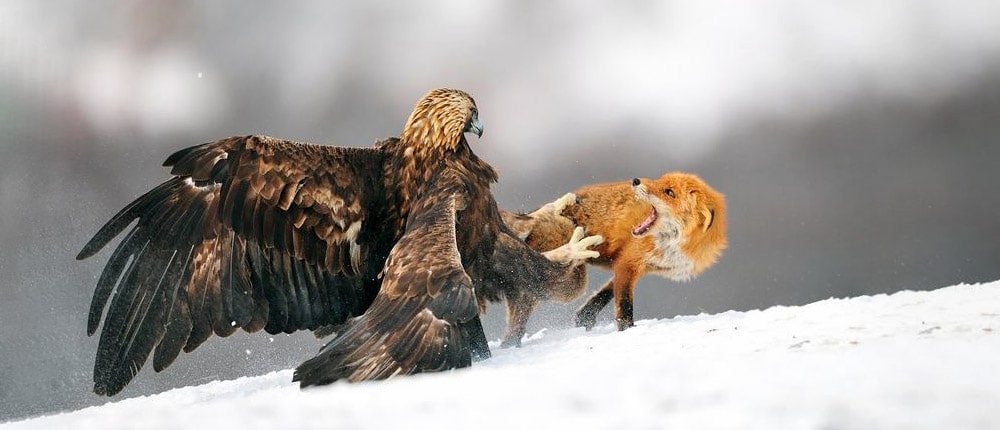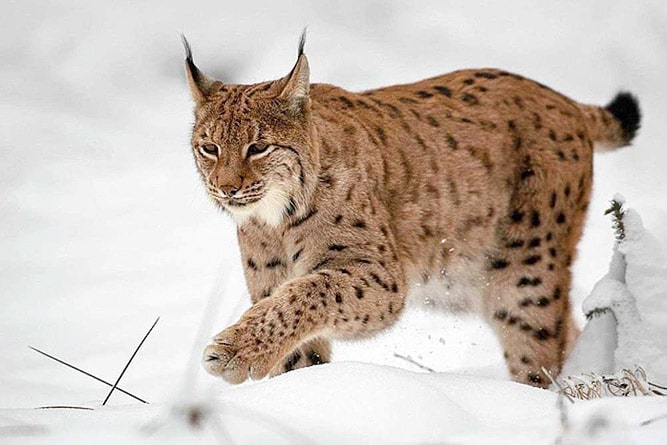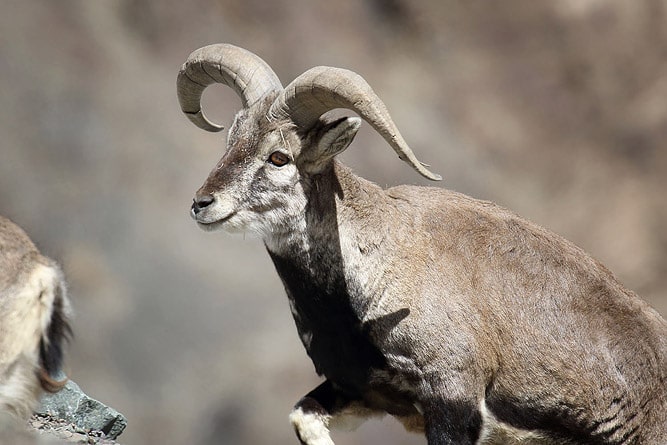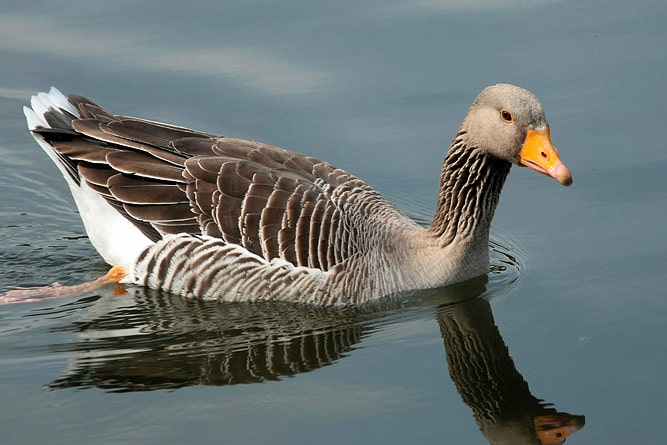Ladakh has a very rich flora and fauna. Several species of them are endemic to the region. Due to its unique climate and topography, distinct species of animals are found in Ladakh. The snow leopard and the black-necked crane are the jewels of the wildlife kingdom of Ladakh along with several other unique birds and mammals.

In the pastures of eastern Ladakh, wild animals and birds are a common sighting and often compete with domestic animals for food. While in the heavily populated Indus valley and the valleys of its tributaries, they are found in the higher reaches but often descend to lower reaches due to scarcity of food, thus resulting in human-wildlife conflict. Several species of mammals which were extensively hunted for fur and wool in the past are now at the brink of extinction. These include the Tibetan antelope, Eurasian lynx and the musk deer which is now extinct in Ladakh.

Due to the revival of Buddhist traditions and the increasing awareness of the populace regarding the importance of preservation of environment, the future looks seemingly bright for the wildlife of Ladakh.
Wild yaks fighting (acrobatic move) 🤣🤣🤣
Mammals of Ladakh
1. Snow Leopard

The snow leopard is one of the rarest mammals in the world. Called Schan in Ladakhi language, it is the king of snow-capped mountains. It is smaller and lighter than a common leopard. The snow leopard is a nocturnal animal and is very elusive. It is adapted to live in some of the most climatically hostile environments, in high-altitude mountains and extreme cold. The head, nape and lower parts of legs have black spots while the body and tail is covered with larger rosettes and the belly is witish. The snow leopard inhabits areas especially between 3,000m and 5,000m. It is found throughout Ladakh especially in southern and central Ladakh. Hemis National Park is the best place to view this ‘Grey Ghost’.
2. Tibetan Wolf

Called Shangku in Ladakh, the Tibetan wolf is a sub-species of grey wolf. It is around 76 cm tall and about 110 cm in length. It weighs around 30-35 kg. It is larger than the other sub-species of wolf found in the Indian Peninsula. It has a blackish summer coat and a brownish thick woolly fur in winter. Its fur is black on the back while yellowish white on face, belly and limbs. The Tibetan wolf is found mostly in the mountains during summer and in the upper reaches of valleys during winter. It mostly preys on rodents but often hunts livestock leading to retaliatory killing by the locals. It lives mostly in Changthang region, Zanskar, Upper Suru valley and Markha valley.
3. Eurasian Lynx

Like the snow leopard, the Eurasian lynx is one of the rare mammals on the planet. It is almost extinct in Europe, since it has been extensively hunted for its fur which is in great demand in the fashion industry. Its body is reddish grey with spots over the upper limbs. Its distinctive feature is long tufts of hair on its erect, triangular shaped ears. The Eurasian lynx inhabits in areas at an altitude of over 4,000m. It is a diurnal mammal, especially active at dusk and dawn. It hunts marmots, hares, young ones of bharal and domestic sheep and goats. It is mostly found in the Nubra valley near Hunder and Panamik and in Gya-Meru area.
4. Red Fox

Known as Watsey in Ladakhi, the red fox is common throughout Ladakh. Its coat is reddish in colour. It is covered with long, silky fur for which it is extensively hunted. As a result, its population is declining. The red fox is active at night but can also be seen at dawn and dusk. It is a very shy and wary animal. It is mostly found individually as well as in monogamous pairs. The red fox lives in crevices and burrows. It feeds on marmots, mouse-hares, rodents and birds.
5. Himalayan Brown Bear

The Himalayan brown bear is a sub-species of brown bear. It has a reddish brown coat. It is regarded as one of the largest carnivore in the Himalayas. It has a large head with small eyes, a heavy body with stocky limbs and flat claws. The Himalayan brown bear lives individually or in small groups with female and cubs. It prefers bare, open areas. It is active both during daytime and at night but rests during midday. It goes into hibernation from November to May. The Himalayan brown bear is territorial with the male territory larger than the female’s. It is omnivore and feeds on fresh grass, insects, rodents, roots, bulbs, carcasses and even livestock. It is found in western and southern Ladakh.
6. Asiatic Ibex

Known as Skyin in Ladakhi, the Asiatic ibex resembles the wild goat. It is a sturdy animal with horns curved backwards. Earlier, its horns were used for making bows in Ladakh. It has a brownish dense, short coat. The back of legs and the tip of tail are whitish. In the cold season, a dense undercoat helps it to withstand the extreme winter temperatures. The Asiatic ibex lives in herds with the males and females living separately but they come together during the mating season. It prefers high altitude pastures on rocky slopes and steep hillsides. The Asiatic ibex is a shy and an ever-vigilant animal. It dwells between altitudes of 3,500 m and 5,000m. It is mostly found in western, southern and central Ladakh.
7. Blue Sheep or Bharal

The blue sheep or bharal is not a true sheep, but rather placed between a sheep and goat as it grazes like a sheep and can climb up high and inaccessible cliffs like a goat. It is called Napo in Ladakhi. It has a slate blue coat which turns reddish brown during the warmer months. It has a sturdy body with a short, black tipped tail. Males have large rounded horns directed sideward while females have short and straight horns with a smaller body as well. Its eyesight, sense of smell and hearing are quite sharp. The blue sheep feeds on herbs, grasses and shrubs. Its habitat lies in alpine pastures and rocky hills between the tree line and snow while during winter it descends to an altitude of 3,500m. It is widely distributed across Ladakh.
8. Ladakh Urial

Called Shapo in Ladakhi, the Ladakh urial is the smallest of wild sheep. It is native to Ladakh and is one of the three sub-species of urial. The horns are curved backwards. The distinctive feature of the Ladakh urial is that the tip of the horns point forward. The body is reddish tan in colour, earning it the epithet ‘red sheep’. The Ladakh urial is an alert and agile animal. It lives in herds. During the breeding season, the male visits several herds. It is found in the Indus and Shayok river valleys. As humans inhabit these valleys, there is a continual loss of habitat, due to which its population is decreasing. As a result, it is listed as a vulnerable species.
9. Tibetan Antelope

The Tibetan antelope is known as Rtsos in Ladakhi. It is prized for its fine wool, called shahtoosh, meaning ‘king of wools’. Because of this, the Tibetan antelope has been extensively hunted to make shawls and its population has rapidly dwindled. It is classified as a vulnerable species. Its body colour is brownish with white parts and it has long, slender horns. The Tibetan antelope is a very shy and wary animal, it often runs very fast when it feels threatened. It generally lives in large herds. It has an inflated snout which consists of a sac meant to breathe rarefied air of the high-altitude areas. The Tibetan antelope feeds on herbs and grasses. It is found in northern and eastern Ladakh on the high-altitude plateau in the Pangong lake area.
10. Tibetan Argali

The Tibetan argali is called Nyan in Ladakhi. It is the biggest of all the wild sheep. It resembles the antelope in that it has a massive body and long legs. Its coat is light brown, darker at the shoulders while the rest of the body is white. The Tibetan argali has massive horns not exceeding a single circle. The male and the female live in separate herds outside the breeding season. It prefers high-altitude open areas at an altitude of over 4,000m and rarely descends below this level. It feeds on herbs, grasses and sedges. The Tibetan argali is commonly sighted in eastern Ladakh and in some parts of central Ladakh.
11. Tibetan Gazelle

Known as Goa in Ladakhi, the Tibetan gazelle is stocky with a barrel-shaped body, grey in colour, with thin legs and black-tipped tail while the under parts are whitish. It has short, sharply curved horns. It lives in sexually separated herds outside the breeding season. The Tibetan gazelle prefers high-altitude open grasslands and barren steppes between 4,000m and 5,500m. It is found in small groups. It is a very shy and vigilant animal, and runs very fast on the slightest of suspicion. The Tibetan gazelle was once widely distributed across eastern Ladakh but there remain only 70-80 gazelles today. The Tibetan gazelle is included in the list of threatened animals.
12. Tibetan Wild Ass

Known as Kiang in Ladakhi, the Tibetan wild ass is a separate species of its own. It has a large body with a massive head and a short, erect, black-brown mane. Its body is reddish brown on the back with white under part and a long tail with black tuft. The Tibetan wild ass is found between altitudes of 4,000m and 5,200m near wetlands and marshes. The male and female live in separate herds outside the mating season. It is ever-vigilant of threats and runs fast at the slightest of danger. It is found widely in eastern Ladakh (Tso Kar and Tso Moriri area) and in some parts of central Ladakh such as the Markha valley. It is listed as a vulnerable species.
13. Himalayan Marmot

Called Phia in Ladakhi, the Himalayan marmot is one of the two species of marmot found in Ladakh. It is perfectly adapted to the extreme conditions of Ladakh’s mountains. Its body is squat with short limbs and a very short tail; it is pale in colour mixed with black on the top while the face is dark brown. The Himalayan marmot lives in colonies in excavated burrows in open grasslands and grass strewn stony slopes. The burrows are also used for hibernation. The marmot hibernates for around 6-7 months. It feeds on grasses, roots, leaves and seeds of various plants. It is regularly killed for meat and fur due to which it is classified as a threatened species. The Himalayan marmot is found between the altitude of 4,000m and 5,000m. It is widely distributed across the region and it is commonly spotted during treks in Ladakh.
14. Ladakh Pika

Known as Zabra in Ladakhi, little is known about the Ladakh pika’s ecology. The Ladakh pika has soft fur which is pale in colour with yellowish white under parts. It has a large skull with small ears. It is a social animal living in family groups in clearly marked territories. Its habitat is high-altitude, semi-desert plains. It lives in burrows. The Ladakh pika is a diurnal creature active throughout the year. It is on the move during morning and afternoon, and takes a sunbath at midday. It is a very alert and vigilant animal. It dwells at an altitude between 4,500m and 5500m. It is widely found in Ladakh.
15. Woolly Hare or Tibetan Hare

The woolly hare or Tibetan hare is known as Ribong in Ladakhi. It has thick and curly fur with a bushy tail, long hind legs and black tipped ears. It has a pale eye ring, a brownish-grey coat and white under parts and tail. Its habitat is mountain slopes and meadows. The woolly hare is active during dusk and dawn while spending the day in shallow dugout depressions. It is lives at altitudes between 4,000m and 5,500m. It has excellent hearing and eyesight. It is found in most parts of Ladakh. Not much is known about this animal. There are around 5-7 sub-species of this hare on the Tibetan plateau.
Birds of Ladakh
16. Black-necked Crane

Known as Cha Thung Thung in Ladakhi, the Black-necked crane is an endangered species. It is found in Ladakh only during summer when it migrates there from lower altitude regions of Central Asia. It has a height of about 135 cm and weighs around 5-6 kg. It has a pale body with a black neck and black elongated tail feathers, and a red patch of skin on its head. It is native to Inner Asia and is mostly found near high altitude lakes and pastures. Its diet includes plant roots, tubers, fish, shrimp, insects, snails, grains, etc. In Ladakh, the Black-necked crane is found in the wetlands of the Changthang region. Feral dogs and increasing human encroachment, however, have put these birds in grave danger.
17. Golden Eagle

Known as Gyaplak in Ladakhi, the golden eagle is found throughout Ladakh, mostly in mountainous areas up to an elevation of 3,600m. Its length is 70-85 cm and it has a wingspan of 185-220 cm. It weighs between 3 and 6 kg. Its body is largely dark brown in color with a golden nape and crown. It is named for this distinctive feature. The female is larger than the male; it breeds from March to August. The golden eagle lives for over 30 years in the wild and over 40 years in captivity. It feeds on small mammals, fish, ungulates and even geese or cranes.
18. Himalayan Vulture

Called Thangkar in Ladakhi, this predator is native to High Asia. The Himalayan vulture is one of the largest vultures of the Eurasian landmass. It is sighted at altitudes up to 6,000m. It has a brown body with a featherless head. It has a length of 95-130 cm and a wingspan of 270-300 cm. Its weight ranges from 8 to 12 kg. The Himalayan vulture breeds during winter and lays only 1 egg per season. Little is known about its lifespan. It is found in mountainous terrain and it nests on cliff faces. It feeds on carcasses of large mammals especially yaks, Tibetan wild asses, Tibetan antelopes and even those of humans. It is found in Changthang region, Upper Indus basin, Zanskar and Kargil district.
19. Lammergeier

The lammergeier is known as Skiaklag in Ladakhi. The sub-species of lammergeier found in Ladakh is one of the 13 such sub-species in the world. It resides at altitudes of up to 5,000m. It measures 94-125 cm in length and has a wingspan of about 231-284 cm. It weighs around 4.5-7 kg. It has a greyish-black body with long, black bristles which look like a beard, because of this feature, it is also known as bearded vulture. It has a lifespan of over 20 years in wild and over 40 years in captivity. The lammergeier is scavenger by nature and bones make up the majority of the diet which is very unique. It preys on small mammals and reptiles. In Ladakh, it is found in the Changthang region, Zanskar and Suru valley.
20. Brown-headed Gull

Known as Nyagar in Ladakhi, the brown-headed gull is a summer visitor to Ladakh where it breeds in the wetlands of Changthang region and Upper Indus valley. It is classified as a least threatened species. The brown-headed gull has a white cream-colored head in case of a breeding adult and a dark ear patch in case of a non-breeding adult or a less than a year-old bird. Its length is 40-45 cm and it weighs 450-700g. It has a lifespan of 11 years. Its diet is mostly composed of fish and invertebrates.
21. Snow Partridge

The snow partridge is a member of the partridge family found in the high-altitude regions of Southern Central Asia. It resides above the tree line in pastures, stony, open hillsides and mountain ridges. The snow partridge is less shy and wary than other game birds. It has grey and white specks on the upper part of the body with brownish streaks on white underparts. It has a red bill and legs. Its length is 38-40 cm and it weighs 450-700g. The male is slightly larger than the female. It feeds on mosses, lichens, berries and shoots.
22. Chukar Partridge

Known as Srhakpa in Ladakhi, the chukar partridge is a common sight in Ladakh. Its body resembles that of a fat chicken and is a medium sized partridge. Its length is 34-38 cm and it has a wingspan of 50 cm. It weighs around 500-750g. It has a pale brownish body with bold, black bars on the sides. The chukar partridge lives on steep rocky slopes. The sub-species found in Ladakh is one of 14 such sub-species found in the world. Previously, it was favored as a game bird but, luckily, its population remained unaffected. It feeds on grass, seeds and shrub fruits.
23. Eurasian Eagle Owl

Called Ugpa in Ladakhi, the Eurasian eagle owl is the largest owl in the world. It prefers to live in rocky landscapes but is also adaptable to other habitats. Its distinguishing feature is its large, piercing orange eyes. Its body is mainly brown-black in color with a white throat. Its length varies from 58 to 71 cm and it has a wingspan of 1.5-2m. It weighs around 1.6-4.2 kg. It mates during winter and early spring. The Eurasian eagle owl lives for 20 years in the wild and 60 years in captivity. It is a nocturnal creature. It feeds on mice, vole, rats, deer fawns, foxes, ducks and even other predators. In Ladakh, it is sighted in eastern Ladakh and in the Nubra valley.
24. Tibetan Snowcock

Known as Tecok, Teok or Congmo in Ladakhi, the Tibetan snowcock is found at altitudes between 3,700m and 5,800m. It has a length of 50-56 cm and the male weighs between 1,500-1,700g while the female weighs between 1,100-1,600g. It has a white, heavily streaked body with greyish patches and a red bill in summer. The male has spurs on the legs while the spurs are absent in females. The Tibetan snowcock feeds on roots, seeds, leaves, berries, etc. It is one of four such sub-species found in the world. It is found around high mountain passes in Ladakh.
25. Himalayan Snowcock

Called Ripja or Kongmo Jukar in Ladakhi, the Himalayan snowcock is one of four subspecies of snowcocks, one of the others being the Tibetan snowcock. As its name suggests, it is found in the Himalayan range overlapping with that of the Tibetan snowcock. However, the Himalayan snowcock lives on lower elevation than the Tibetan snowcock. It lives on cliffs and rocky slopes. Its length is 54-72 cm and its wingspan is 86-97 cm. It weighs around 2-3.5 kg. It feeds on grasses, tuber, berries, leaves, etc. The Himalayan snowcock is found at altitudes between 3,600 and 4,500m. In Ladakh, it can be sighted in the Hemis National Park, Suru, Drass, Zanskar, etc.
26. Gadwall

The gadwall is known as Jungnagma in Ladakhi. The male has a grey-brown body while the female has a brown patterned body. The other distinguishing character of the female is thin orange colored edge of the bill while the male has a completely dark bill. It measures 46-57 cm in length and has a wingspan of about 85 cm. It weighs around 500-1,250g. The gadwall feeds on submerged plants, seeds and aquatic invertebrates but it does not dive. It only tips forward while feeding. In addition to these, it also eats fish, insects, mollusks, crustaceans and amphibians. It is classified as a least threatened species. It is found in the marshes and wetlands of Shey and Changthang region.
27. Bar-headed Goose

Known as Ngangpa in Ladakhi, the bar-headed goose breeds in the mountain lakes of the Himalayas and Central Asia. In winter, it flies across the Himalayas to South Asia. This migration is the highest by any bird. It has been spotted flying at altitudes of over 9,000m above sea level. Its length is 68-78 cm and weighs 2-3 kg. It has a wingspan between 140 and 160 cm. Its habitat lies at altitudes up to 4,000-6,000m. The bar-headed goose has a grey body with orange legs and is named for the black bars on the back of its white head. It feeds on grasses, grains, fish and insects. In Ladakh, it is found in the wetlands of Changthang region and in the Upper Indus basin.
28. Greylag Goose

The greylag goose is the largest bird in the grey geese family. It visits Ladakh during its non-breeding season. It has a greyish body with white belly and has an orange bill. It has a length of 76-89 cm and a wingspan of 147-180 cm. It weighs around 2.1-4.5 kg. The greylag goose has a lifespan of 20 years. It feeds on grasses, grains, carrots, potatoes, fruits, nuts, amphibians, fish, insects, mollusks, etc. It reaches sexual maturity at the age of 2-3 years. Feral dogs constitute a great threat to this bird.
29. Brahminy Duck or Ruddy Shelduck

The Brahminy duck, also called ruddy shelduck, is considered sacred by the Buddhists. In Ladakhi, it is known as Muru. It has an orange brown body with a length of 58-70 cm and a wingspan of 110-135 cm. It weighs around 1.2 kg. It is a migratory bird and lives in open country. It usually resides around high-altitude brackish water lakes. The Brahminy duck breeds in burrows, crevices or tree holes. It lays 6-15 eggs at a time and the incubation period is 30 days. It is known to be a very vigilant bird. It is found in the high-altitude wetlands of Changthang region near Pangong lake and Tso Moriri lake and along the Upper Indus basin.
30. Eurasian Wigeon

Known as Gobrakpa in Ladakhi, the Eurasian wigeon is a migratory bird known for covering long distances in between its breeding and non-breeding habitats. It measures 45-58 cm in length and has a wingspan of 75-86 cm. It weighs around 410-970g. The Eurasian wigeon can be described as a medium-sized duck. The male has a largely grey body while the female has a greyish-brown body with a white belly. It feeds on leaves, stems, roots and seeds of both aquatic as well as terrestrial plants. It mostly prefers wetlands and slow-moving rivers. In Ladakh, it is mostly found in the wetlands of Changthang region, Upper Indus basin and the Shey marshes.
